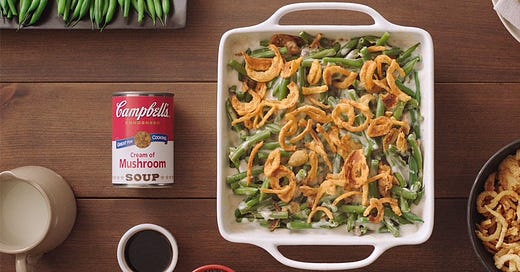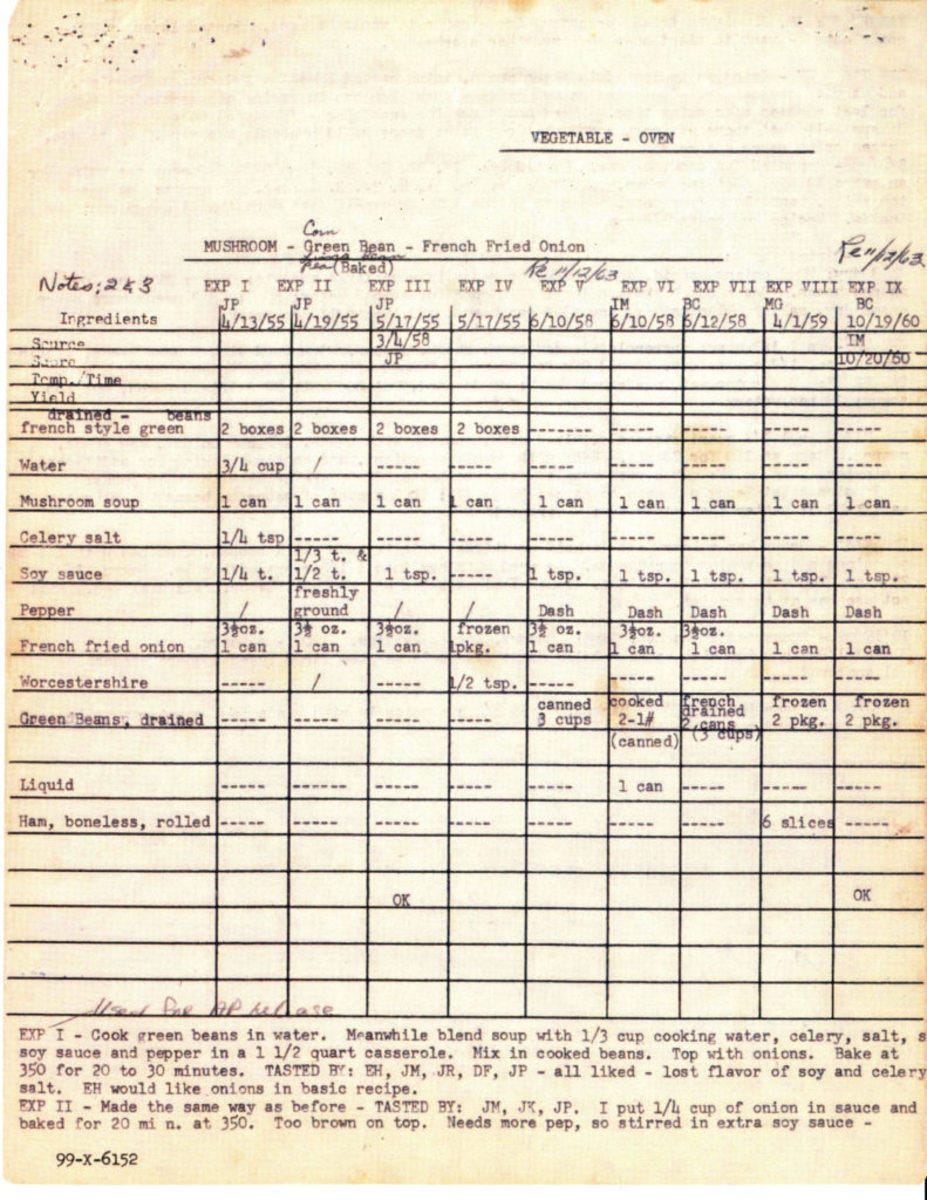Green Bean Casserole
On a royal barbecue, convenience cooking, and the invention of an American classic
In 1955, Florida citrus magnate John Snively, Jr. and his wife May hosted a barbecue for Shah Mohammed Reza Pahlevi and Queen Soraya of Iran.
The Snively family spent all day supervising the cooking and setting the table for dozens of guests expected at the barbecue. But, shortly before the dinner, the chief of protocol for the Iranian royals arrived and informed the Snively couple that one of the rooms would need to have all tables cleared except for one. The Shah and the Queen would dine there alone.
During the barbecue, Spencer — the Snively’s butler of many years — served the royal couple in their private dining room. Each time Spencer offered the Queen a dish, she asked him what was in it before deciding if she wanted some. This continued for every dish that was served, and Spencer eventually lost his patience.
So, when he served a special vegetable casserole and the Queen asked what it contained, Spencer curtly answered: “Listen, lady. It’s just beans and stuff.”
The Queen dug in. She loved the dish.
A few months later, Cecily Brownstone — the Associated Press’ Food Editor — heard this story from the Snivelies, and she wrote an article about it.
The Associated Press wanted to publish a recipe for “beans and stuff” alongside the article, so they called up Campbell’s Soup. The request made its way to Dorcas Reilly, who was a supervisor in the home economics department of the Campbell’s test kitchen.
And Reilly went to work. She wanted to create a “beans and stuff” recipe that would be accessible for the average American home cook. “We worked in the kitchen with things that were most likely to be in most homes,” Reilly said of creating the recipe.
So, while she initially considered adding celery salt and ham to her “beans and stuff,” Reilly settled on something simpler: Only six ingredients — including green beans, fried onions, and Campbell’s cream of mushroom soup — that could be stirred together and cooked in under half an hour.
With that, the green bean casserole was born.
The prep and effort needed were minimal. “It’s so easy, and it’s not an expensive thing to make,” Reilly noted. Because of the dish’s simple ingredients and elegant backstory, food historian Laura Shapiro describes it as “convenience with a touch of glamour.”
The recipe was initially published with the Associated Press article under the title “Beans and Stuff.” But, it really took off when Campbell's started printing it on their cans of cream and mushroom soup; they called it “Green Bean Bake.”
The dish embodied the convenience cooking that was all the rage in the 1950s American kitchen.
As more women worked outside the home but were still expected to assume cooking responsibilities, they turned to quick and easy options to prep dinners: The TV dinner exploded in popularity. Frozen food options proliferated. And, dishes that integrated canned ingredients — like the cream of mushroom soup at the center of Reilly’s green bean casserole recipe — became a staple of the American diet.
And, today, green bean casserole is embedded within American food culture. Modern cookbooks often call the dish “a classic” and “traditional.” As of 2020, Campbell’s estimates that around 20 million households will serve the dish for Thanksgiving.
The casserole is (to borrow the phrase coined by historian Eric Hobsbawm) an “invented tradition.” It’s a dish that’s seen as old but in fact is quite young; it was invented less than 70 years ago. Per Hobsbawm’s definition, these invented traditions are deliberately constructed and maintained to promote a specific culture.
And the casserole does just that. Constructed by Cecily Brownstone, by Dorcas Reilly, by the Shively family, by generations of home cooks, it captures a culture of convenience, of diplomacy, and of American hospitality.
Happy Thanksgiving — and thank you for reading, today and always.









Great read. What % of the common dishes we eat were invented within the last hundred or two hundred years, do you think? For example, quotes from wikipedia:
* The names pasta alla carbonara and spaghetti alla carbonara are unrecorded before the Second World War.
* The hamburger as it is known today has multiple invention claims ranging between 1885 and 1904
* Ciabatta bread was first produced in 1982
My Swedish MIL says she remembers seeing a pizza for the first time in about 1973 or so. Although to be fair, the Roman soldiers had known about that one two thousand years earlier.
Always thought that casserole looked like upchuck. A waste of green beans and extra effort.